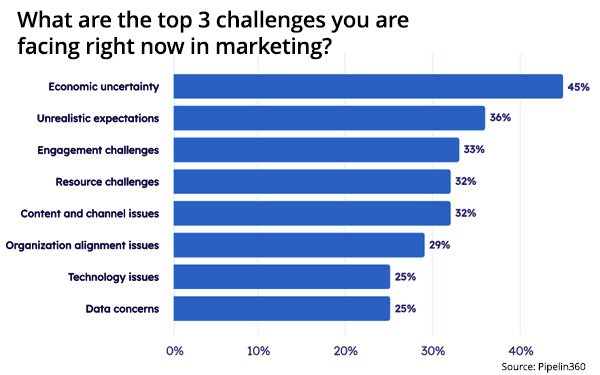
Most B2B brands use email as a lead generation device.
But there is one little problem:: 33% are struggling with declining engagement metrics, including declining email open rates and form fills, according to the State of B2B Pipeline Growth, a study from
Pipeline360.
AI might help them, but this is not yet clear.
Of course, metrics are not their only challenge. They also worry
about:
- Economic uncertainty—45%
- Unrealistic expectations—36%
- Engagement
challenges—33%
- Resource challenges—32%
- Content and channel issues—32%
- Organization
alignment issues—29%
- Technology issues—25%
- Data concerns—25%
advertisement
advertisement
Another
challenge is that sales cycles have gotten longer for 74% of the respondents.
Then there is funnel friction. These are the most problematic stages:
- Closing deals—38%
- Retaining customers—38%
- Qualifying leads—36%
- Nurturing
leads—34%
- Generating leads—28%
Meanwhile, 31% report flat budgets and 32% budget decreases. In contrast, 38% see increases.
Headcounts are growing at 40% of B2B firms, holding steadty at 45% and shrinking at 16%.
Budgets aside, email marketing retains its usage dominance as a lead generation
channel. The respondents use:
- Email marketing—66%
- Paid social—58%
- Paid search—50%
- SEO—47%
- Email or webinars—45%
- Direct mail or offline campaigns—35%
- Referrals or partner programs—27%
(Email usage is 3% higher than it was in July 2024).
The respondents are also turning toward AI, with email
ranking high as an imperative. They see these AI or machine-learning applications as most valuable:
- Generative AI for content
creation—36%
- AI for email marketing optimization—36%
- ML for customer
insights—30%
- AI for lead scoring—29%
- Generative AI for ad copy—28%
- AI for
predictive analytics—28%
- AI-driven chatbots—27%
- ML for sales forecasting—19%
- ML for pricing
optimization—14%
- None of the above—5%
Pipeline360 surveyed 534 B2B marketing professionals in the U.S.,
UK, Europe and Asia in February 2025.